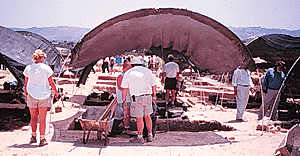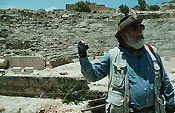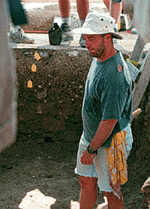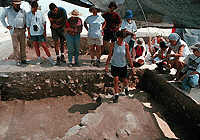|
Excavations at Sepphoris, Israel May 8 — June 4 and June 7 — July 8, 2000 Sepphoris, a major Roman and Byzantine city only four air miles from Nazareth, was first excavated for one season in 1931 by the University of Michigan.  It has been under excavation since 1983
by the University of South Florida Excavations at Sepphoris under the direction of James F. Strange. It has been under excavation since 1983
by the University of South Florida Excavations at Sepphoris under the direction of James F. Strange.
Sepphoris remained a loyal Roman city of largely Jewish population through the First and Second Jewish Revolts against Rome. In the second century CE it took the name Diocaesarea and became a great Jewish intellectual center. Judah the Prince lived at Sepphoris the last seventeen years of his life beginning about 203 CE and edited the Mishnah there. In the fourth century there was an attempt to build a church at Sepphoris. Later, Marcellinus, Bishop and Patriarch of Diacaesarea, participated in the Council of Jerusalem in 518 AD. A lintel stone with Greek inscription from his church has been found.
Two sessions are planned for 2000. Students from Illinois Wesleyan University will be given priority consideration for enrollment in the first session, from May 8 through June 4, although other applicantions are encouraged. The second session, from June 7 through July 8 will draw together an excavation team more widely assembled from several colleges, universities, and other institutions, as well as volunteers who are not enrolled as students. Both sessions, under the direction of Dr. James F. Strange of the University of South Florida in Tampa, Florida will continue excavations in the Early Roman to Byzantine basilical building. The Associate Directors are Thomas R.W. Longstaff, Crawford Family Professor of Religious Studies at Colby College in Waterville, Maine and Dennis E. Groh, Professor of Humanities and Archaeology and Chaplain at Illinois Wesleyan University in Bloomington, Illinois. No previous experience or archaeological training is necessary.
The full season of excavations includes:
COSTS AND CREDIT: For applications write the address below or use our electronic application form by choosing this link. The cost for each session is yet to be determined, and includes full room & board, round-trip fare from New York, two Saturday guided trips, transportation to and from the site daily, transportation of breakfast to the site, and lectures by the staff of the expedition. Tuition for credit is not included. Undergraduate academic credit for this program will normally be given through the Overseas Study and Exchange Programs of the University of South Florida at an extra cost of $75.21 per credit hour for Florida residents and $308.16 for non-residents. Graduate credit is available by agreement with your university for a higher fee.
The IRS has ruled the participation on an excavation at the level of data-gathering is tax deductible, but furthering one's education is not.
Consult with your tax advisor.
ACCOMMODATIONS are at a kibbutz, a small collective settlement, west of the site. Participants are assigned two or three to a room in a youth hostel environment, sometimes with a bath down the hall. The Hostel and the Annex both have common rooms with hot coffee or tea available. In addition, the kibbutz has a common dining room, tennis courts, basketball courts, grass and trees, a swimming pool, a telephone, and an outdoor lecture area for our lectures. Horseback riding and donkeyback riding are available in the vicinity for a fee. Participants can rent cars for the weekend and are free to travel Saturdays and Sundays, though those taking courses for credit are expected to join the weekend tours. For Applications or more information you may write:
Dr. James F. Strange, Professor
Office: 813-974-1859
Barbara Pilcher, Administrative Assistant You may also click here to send E-mail to Professors Strange and Longstaff
Bookstore | Contact All materials contained in the CenturyOne Foundation Web Site are protected by copyright and trademark laws and may not be used for any purpose whatsoever other than private, non-commercial viewing purposes. Derivative works and other unauthorized copying or use of stills, video footage, text or graphics is expressly prohibited. |
 From ancient literary notices we know that Sepphoris had a theater, ten synagogues, several churches, a Council Chamber, an Archive, two market places, temples, a city wall, a mint (Sepphoris minted its own coins), an extensive aqueduct system, and a cemetery. In our excavations since 1983 we have excavated a Jewish villa first excavated by the University of Michigan in 1931, a bathing establishment, and an enormous market building or basilica with stunning mosaics built in the first century CE and going out of use 350 years later.
From ancient literary notices we know that Sepphoris had a theater, ten synagogues, several churches, a Council Chamber, an Archive, two market places, temples, a city wall, a mint (Sepphoris minted its own coins), an extensive aqueduct system, and a cemetery. In our excavations since 1983 we have excavated a Jewish villa first excavated by the University of Michigan in 1931, a bathing establishment, and an enormous market building or basilica with stunning mosaics built in the first century CE and going out of use 350 years later.

